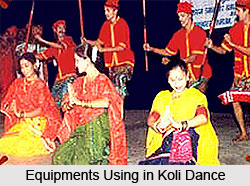 Equipments or means are an important part of Folk dances and they are the means, with the help of which the dances are performed and they give a separate identity to the folk dance. Many times, folk dances are termed as per the name of the equipment used. E.g. Kaavadi is used in one of the performance of a dance in Kerala, from it the dance is known as Kaavdiattom.
Equipments or means are an important part of Folk dances and they are the means, with the help of which the dances are performed and they give a separate identity to the folk dance. Many times, folk dances are termed as per the name of the equipment used. E.g. Kaavadi is used in one of the performance of a dance in Kerala, from it the dance is known as Kaavdiattom.
Apart from an identity, the equipments also represent the local culture & historical linking with the performance. But sometimes, these equipments are only musical instruments, which give background music and hence, considered as an important ritual character, a significant part of all social and devotional ceremonies. This shows us the ritual & ceremonial relation of equipment with folk dancing. With the use of a particular equipment, dance pattern or steps are coordinated that sets a continuous tempo for artistic performance of the dance. This makes the dance a unique from rest of all. The Koli community from Maharashtra is known as a fishing community, where fishing is their main occupation, and the oars play as important role in their work. Similarly, they use Oars in performing their dances, Koli dances.
Local culture & geographical conditions had a great influence on the Indian folk dances. Some of the rituals are obeyed in folk dances also. From south India, many temple performing arts or drama are done with wearing an elaborate mask. Such dance or drama depicts the glory and triumph of Bhagavathy over the demons. Such masks are made up of certain material & are coloured in a typical way, giving inherent characteristics to the performance. Such mask is also plays a role of equipments used for folk dances. In a nutshell, equipments or means used in a folk dancing not only reflects it`s linkage with local culture but also a religious or social attachment that is carried out from generations.
At large, classifying Folk dances of India on the basis of geographical context is widely accepted. On this basis Indian Folk Dances can fall in the categories of the state folk dances.



















